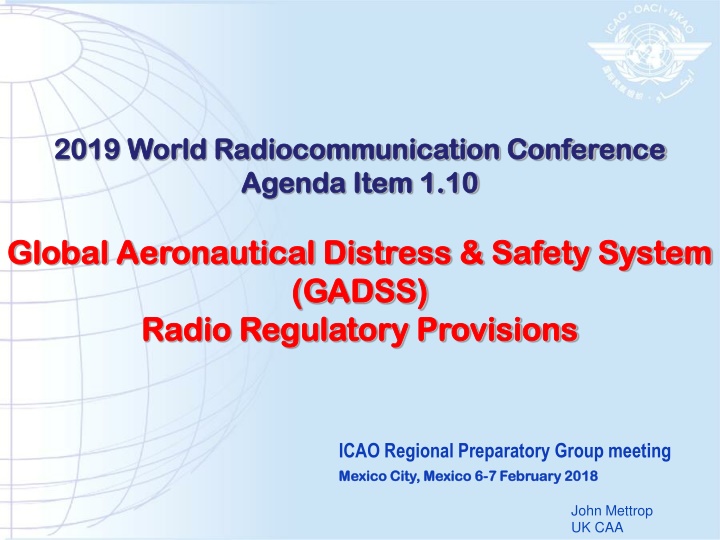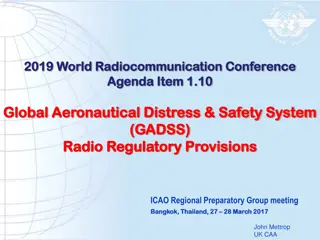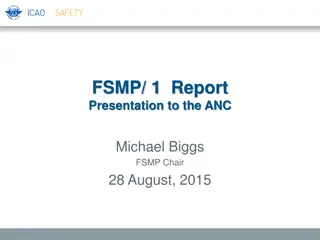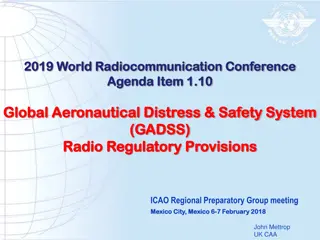
Radiocommunication Conference 2019: Global Aeronautical Distress & Safety System (GADSS) Updates
Explore the agenda of the 2019 World Radiocommunication Conference focusing on Agenda Item 1.10 - Global Aeronautical Distress & Safety System (GADSS). Learn about the regulatory provisions, studies conducted, and the importance of GADSS. Find out why Agenda Item 1.10 is essential in the context of aeronautical communication and safety regulations.
Download Presentation

Please find below an Image/Link to download the presentation.
The content on the website is provided AS IS for your information and personal use only. It may not be sold, licensed, or shared on other websites without obtaining consent from the author. If you encounter any issues during the download, it is possible that the publisher has removed the file from their server.
You are allowed to download the files provided on this website for personal or commercial use, subject to the condition that they are used lawfully. All files are the property of their respective owners.
The content on the website is provided AS IS for your information and personal use only. It may not be sold, licensed, or shared on other websites without obtaining consent from the author.
E N D
Presentation Transcript
2019 World Radiocommunication Conference 2019 World Radiocommunication Conference Agenda Item 1.10 Agenda Item 1.10 Global Aeronautical Distress & Safety System Global Aeronautical Distress & Safety System (GADSS) (GADSS) Radio Regulatory Provisions Radio Regulatory Provisions ICAO Regional Preparatory Group meeting Mexico City, Mexico Mexico City, Mexico 6 6- -7 February 2018 7 February 2018 John Mettrop UK CAA
WRC WRC- -19 Agenda Item 1.10 19 Agenda Item 1.10 to conduct the relevant studies, taking into account information and requirements provided by ICAO for both the terrestrial and satellite components, including: quantification and characterization of radiocommunication requirements related to GADSS, such as: data traffic requirements for different system components of GADSS (such as the aircraft tracking, autonomous distress and flight data recovery systems) and their terrestrial and satellite components at each phase of the operation; information on the radiocommunication requirement related to safety-of-life applications; performance criteria for terrestrial and satellite systems; analysis of the existing allocations to the relevant aeronautical services and determining whether any additional spectrum is required; studies on sharing and/or compatibility with the existing services; to undertake studies of the existing regulatory provisions to determine whether it might be necessary to apply additional regulatory measures, invites ITU-R
GADSS What We Know? GADSS What We Know? Concept Built on use of Existing Systems Deficiencies in Surveillance Capabilities Identified as a result of AF 447 & MH 360 Incidents Addressed at WRC-19 Allocation for satellite ADS-B No need for Additional Allocations Identified No need for Modifications to Existing Footnotes Identified
Why Do We Need Agenda Item 1.10 Why Do We Need Agenda Item 1.10 Normally Concentrate on Article 5 Other Articles and Appendices of Interest Chapter V Administrative provisions Article 18 Licences Chapter VI Provisions for services and stations Article 28 Radiodetermination Chapter VII Distress and safety communication Article 30 General Appendix 12 Special rules applicable to radio-beacons Appendix 27 Frequency allotment plan for the aeronautical mobile (R) service and related information
Why Do We Need Agenda Item 1.10 Why Do We Need Agenda Item 1.10 Chapter VIII Aeronautical Services Article 35 - Introduction Article 36 - Authority of the person responsible for the station Article 37 - Operator s certificate Article 38 - Personnel Article 39 - Inspection of stations Article 40 - Working Hours of stations Article 41 - Communication with stations in the maritime services Article 42 - Conditions to be observed by stations Article 43 - Special Rules relating to the use of frequencies Article 44 - Order of priority of communications Article 45 - General communication procedures Other Articles and Appendices of Interest
Potential Issues Within Potential Issues Within Articles 18, 28, 30,32 & 35 Articles 18, 28, 30,32 & 35- -45 45 GADSS Related Pilot s authority Secrecy Additional Provisions Aviation in General Technical Chapter V Administrative Provisions Article 18 Licences Chapter VI Provisions for Services and Stations Article 28 Radiodetermination Chapter VII Distress and Safety Communication Article 32 Operational procedures for distress communications in the global maritime distress and safety system (GMDSS) Provisions for Other Services
Current Proposals within the ITU Current Proposals within the ITU No allocation issues Need to modify Chapter VII Article 30 in a manner that: GADSS is made up of a number of systems which operate under an allocation to one or more aeronautical services Recognises GADSS whilst avoiding any impact on GMDSS Defines GADSS and its main functions Identifies ICAO as the responsible UN agency further detail Detailed information on the system is contained in ICAO documentation Identifies additional regulatory provisions which are outdated and need to be reviewed at a future WRC PDN Report ITU-R M.[GADSS] (https://www.itu.int/dms_ties/itu- r/md/15/wp5b/c/R15-WP5B-C- 0538!N21!MSW-E.docx) Method A: - Add provisions in Chapter VII that specify that the details of the GADSS elements are contained in Annexes to the ICAO Convention; that the type of radiocommunication service used depends on the requirements of the specific GADSS function, that operation of GADSS elements under RR No. 4.4 is precluded. Draft CPM text on WRC-19 AI 1.10 (https://www.itu.int/dms_ties/itu -r/md/15/wp5b/c/R15-WP5B-C- 0538!N06!MSW-E.docx) Method B: - Add a new article in chapter VII that that the details of the GADSS elements are contained in Annexes to the ICAO Convention; that GADSS shall only operate using primary service allocations; that the GADSS must operate in accordance with the terms of new Resolution
ICAO Position ICAO Position To support studies to identify any regulatory changes required for the implementation of GADSS in accordance with ICAO requirements, and action by WRC-19 to integrate those changes into the Radio Regulations.
Outstanding Questions within the ITU Outstanding Questions within the ITU Chapter VIII Aeronautical Services Whether the provisions of Articles 18.4 and 36.3, taking into account the definition in Article 17, would require that aircraft tracking information be encrypted. Whether the provisions of Articles 36.1, 36.2, 37.1 and 37.2 would preclude GADSS including a provision that the aircraft autonomous distress tracking function could not be turned off. Whether Article 37.3 would preclude GADSS including, under some conditions, a provision for remote triggering of position reporting.
Other Issues that may need Future WRC Action (1) Other Issues that may need Future WRC Action (1) ARTICLE 36 Authority of the person responsible for the station The service of a mobile station is placed under the supreme authority of the person responsible for the aircraft or other vehicle carrying the mobile station. 36.2 2 The person holding this authority shall require that each operator comply with these Regulations and that the mobile station for which the operator is responsible is used, at all times, in accordance with these Regulations. 36.3 3 Except as otherwise provided for in these Regulations, the person responsible, as well as all the persons who may have knowledge of any information whatever obtained by means of the radiocommunication service, are placed under the obligation of observing and ensuring the secrecy of correspondence 36.4 4 The provisions of Nos. 36.1, 36.2 and 36.3 shall also apply to personnel of aircraft earth stations 36.1 1
Other Issues that may need Future WRC Action (2) Other Issues that may need Future WRC Action (2) ARTICLE 37 Operator s certificates Section I General provisions 37.1 station shall be controlled by an operator holding a certificate issued or recognized by the government to which the station is subject. Provided the station is so controlled, other persons besides the holder of the certificate may use the radiotelephone equipment. 1 1) The service of every aircraft station and every aircraft earth 37.2 . 37.3 an aircraft station or aircraft earth station shall be controlled by an operator holding a certificate issued or recognized by the government to which the station is subject. Provided the devices are so controlled, they may be used by other persons 3) The service of automatic communication devices installed in
Other Issues that may need Future WRC Action (3) Other Issues that may need Future WRC Action (3) ARTICLE 18 Licences 18.1 18.2 18.3 18.4 telecommunications, as provided in the relevant provisions of the Constitution and the Convention. Moreover, the licence shall mention, specifically or by reference, that if the station includes a receiver, the interception of radiocommunication correspondence, other than that which the station is authorized to receive, is forbidden, and that in cases where such correspondence is involuntarily received, it shall not be reproduced, nor communicated to third parties, nor used for any purpose, and even its existence shall not be disclosed. 2 . The holder of a licence is required to preserve the secrecy of
Other Issues that may need Future WRC Action (4) Other Issues that may need Future WRC Action (4) ARTICLE 28 Radiodetermination Services 28.16 radio direction-finding station for a bearing shall use for this purpose a frequency on which the station called normally keeps watch. 9 In the absence of prior arrangements, an aircraft station which calls a Section IV Radiobeacon stations When an administration thinks it desirable in the interests of navigation to organize a service of radiobeacon stations, it may use for this purpose: 28.19 a) radiobeacons properly so-called, established on land or on ships permanently moored or, exceptionally, on ships navigating in a restricted area, the limits of which are known and published. The emissions of these radiobeacons may have either directional or non-directional patterns; 28.20 b) fixed stations, coast stations or aeronautical stations designated to function as radiobeacons, at the request of mobile stations. 28.18 11
Other Issues that may need Future WRC Action (5) Other Issues that may need Future WRC Action (5) ARTICLE 32 Operational procedures for distress communications in the global maritime distress and safety system (GMDSS) Section III Distress traffic C Locating and homing signals 1) Locating signals are radio transmissions intended to facilitate the finding of a mobile unit in distress or the location of survivors. These signals include those transmitted by searching units, and those transmitted by the mobile unit in distress, by survival craft, by float-free EPIRBs, by satellite EPIRBs and by search and rescue radar transponders to assist the searching units. 32.62 2) Homing signals are those locating signals which are transmitted by mobile units in distress, or by survival craft, for the purpose of providing searching units with a signal that can be used to determine the bearing to the transmitting stations. 32.63 3) Locating signals may be transmitted in the following frequency bands: 117.975-137 MHz; 156-174 MHz; 406-406.1 MHz; and 9 200-9 500 MHz. 32.60 32.61 36
Other Issues that may need Future WRC Action (6/1) Other Issues that may need Future WRC Action (6/1) Appendix 12 Section I Aeronautical radiobeacons 1) The assignment of frequencies to aeronautical radiobeacons operating in the bands between 160 kHz and 535 kHz shall be based on a protection ratio against interference of at least 15 dB for each beacon throughout its service area. 2) The radiated power should be kept to the minimum value necessary to give the desired field strength at the service range. The daylight service range of radiobeacons referred to in 1) above shall be based on the following field strengths: 3) 4) Regions 1 and 2 70 V/m for radiobeacons north of 30 N; 120 V/m for radiobeacons between 30 N and 30 S; 70 V/m for radiobeacons south of 30 S. 5) Region 3 70 V/m for radiobeacons north of 40 N; 120 V/m for radiobeacons between 40 N and 50 S; 70 V/m for radiobeacons south of 50 S.
Other Issues that may need Future WRC Action (6/2) Other Issues that may need Future WRC Action (6/2) ICAO Annex 10 Volume 1 3.4.2.1 Recommendation. The minimum value of field strength in the rated coverage of an NDB should be 70 microvolts per metre. Note 1. Guidance on the field strengths required particularly in the latitudes between 30 N and 30 S is given in 6.1 of Attachment C, and the relevant ITU provisions are given in Chapter VIII, Article 35, Section IV, Part B of the Radio Regulations. A. Minimum field strengths required at the boundary of the rated coverage: Latitude By day for 15 dB S/N ratio By night for 15 dB S/N ratio 5 N 5 S 5 15 N&S 15 25 N&S 25 35 N&S >35 N&S 320 V/m (+50 dB) 85 V/m (+39 dB) 40 V/m (+32 dB) 18* V/m (+25 dB) 18* V/m (+25 dB) 900 V/m (+59 dB) 700 V/m (+57 dB) 320 V/m (+50 dB) 120 V/m (+42 dB) 150 V/m (+35 dB) A star shown against a figure indicates that a higher value of field strength probably 2 or 3 times the values shown (plus 6 to plus 10 dB) may be necessary in the presence of high aircraft noise and/or industrial noise




